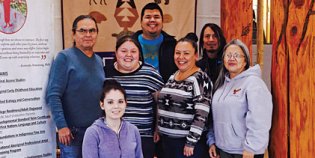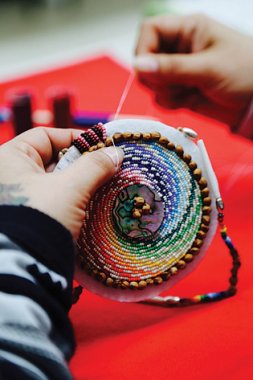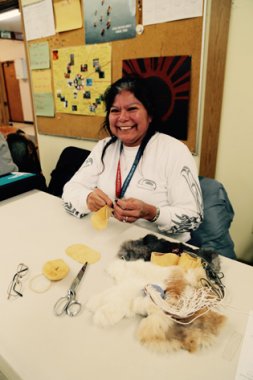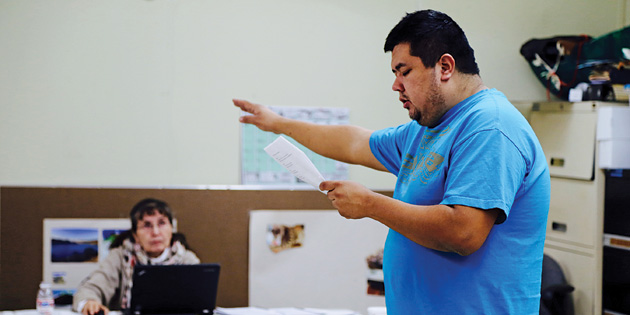En’owkin Centre provides vital support for Syilx traditions
“Swit t? t?twit i kwu acmikstms?”
Shane Kruger walks to the front of a class at the En’owkin Centre and stands before his fellow students of the preforming arts. His posture grows tall and his voice ignites as he tells the tale of the North Wind Monster. He speaks in Nsyilxcen, the language of the Syilx people of the Okanagan. At first, I don’t understand him. Then, slowly, as I watch his body language, listen to the tones of his voice, and follow his movements, I start to feel the meaning. He draws me in to the edge of a cultural divide and builds a bridge on the back of his performance.

Dr. Jeannette Armstrong, an author and educator who is as passionate about creative expression as she is about the traditions and culture of her people, teaches the class. The curriculum is part of the National Aboriginal Professional Artist Training Program (NAPAT), one of the many opportunities offered at the En’owkin Centre in Penticton. The En’owkin Centre is an innovative learning institution that offers a number of programs to support the culture, identity and creative excellence of indigenous people. It’s also a pretty cool building set on a majestic piece of land. The centre was opened in 1999 on the Penticton Indian Reserve, on an area that includes the ECOmmunity Place, a 100-hectare plot currently preserved and protected by the Syilx people.
“We have to find a way to help our kids become successful, and the way is by them knowing who they are.”
After I watch the rest of Shane’s performance, the students take a break and we chat in the central part of the building. It’s a beautiful common area, filled with the art of the students and designed as a giant underground pit house with four huge story poles in the middle, donated by the Stl’atl’imx people. I ask Shane, who grew up speaking English, what’s it’s like to be at the school and to learn and preform in Nsyilxcen. “I think for me, learning about my tradition, my stories and this way of storytelling offers me more of a unique point of view not only of our culture but of the world. Our people and where we come from and how we tell stories, it’s different from the Western style. One thing I’m finding is I’m learning more about our archetypes, our storytelling styles and I think that uniqueness and knowledge is really important.”


The Okanagan Indian Education Resources Society created the centre as a place to revitalize the language and culture of the Okanagan People. Tracey Kim Bonneau is the public relations manager. With a warm and welcoming smile, she tours me around the building, feeds me a bag of freshly made popcorn, and shares her passion for what they do. “The Elders were concerned that the public education system was failing their youth. They said, ‘We have to find a way to help our kids become successful, and the way is by them knowing who they are.’ The board of directors includes the seven bands of the Okanagan Nation Alliance. We affiliate our programs with the higher learning institutions. Once we began, we wrote curriculum and then needed our stuff published, so we bought a small press called Theytus Books. It became Canada’s first indigenous press. Then we needed writers, so we developed the En’owkin International School of Writing.” Their achievements and progress are astounding, all of it accomplished as a non-profit, project-based organization. Their charitable status allows them to accept contributions and endowments to further assist the vision.
I head into another class. This time it’s a language class where students are working on traditional beading. Pat Raphael Derrickson is working on a small pair of moccasins. She grew up in Westbank, the daughter of a Cree mother and a Syilx father. She tells me about her youth when she would sit and bead with her Kokum (grandmother). Taking part in this class allows her to refine her skills, share her knowledge and gain accreditation for her art form. It helps her succeed in other classes as well. “Last year in the immersion class when I did my tests, the only way I could retain the information was if I was actively doing something with my hands and studying for the test, I couldn’t seem to get it until I started working with stuff and then the words would stay,” says Derrickson. The ease with which the rest of the class stays focused, makes art, and speaks in the Nsyilxcen language attests to the effectiveness of how the centre is run. Here, higher learning begins with self-inquiry and leads to speaking with an authentic voice, engaging the world in wonder and the pursuit of excellence, one bead at a time.
As seen in:
[downloads ids=”134694″ columns=”1″]


